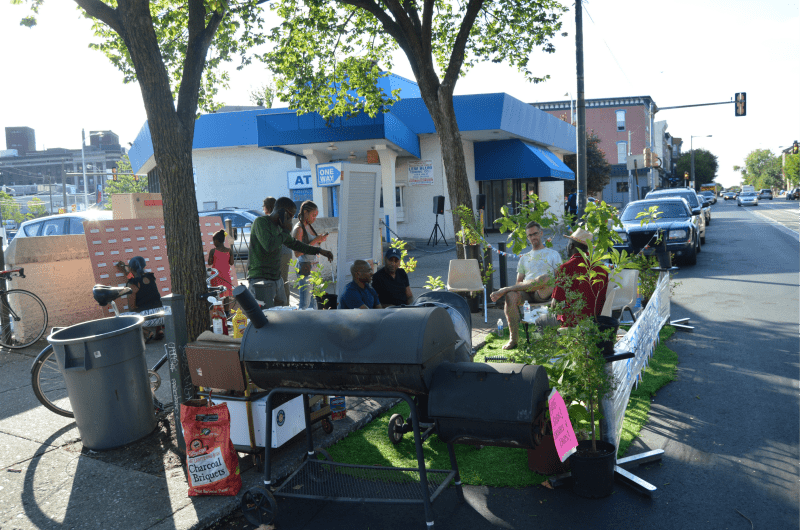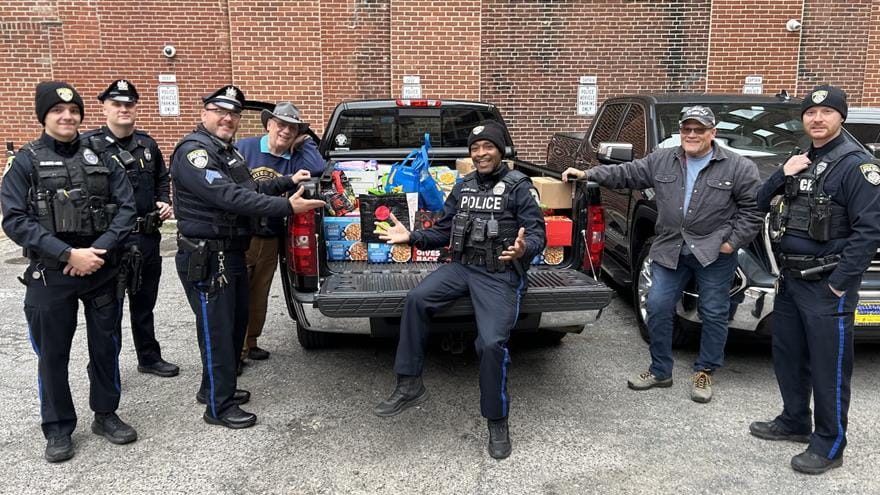Lindy Institute’s New Project Aims to Connect the Community Through Art
 By Ben Seal
By Ben Seal

Community members gather at a barbecue outside of the United Bank building in an early example of the events LoLa 38 will be hosting this spring and summer.
Stroll a few blocks from Drexel’s campus this summer and you might find yourself at the site of a new collaborative project focused on community and arts programming. You’ll find art installations and movie nights, barbecues and games, and conversations about a neighborhood in change and the role art plays in preserving a community’s culture.
It’s all part of LoLa 38, a joint effort from Drexel’s Lindy Institute for Urban Innovation, People’s Emergency Center, Wexford Science + Technology and the University City Science Center that will bring arts and events to the site of the former University City High School at 36th and Filbert streets and the United Bank building at 38th Street and Lancaster Avenue. The project will run from April to October, filling soon-to-be-developed spaces with vibrant public programming that will strengthen Drexel’s connection to the surrounding community — and provide plenty of fun along the way.
“My hope is that what we do draws people to this area,” said Hannah Rechtschaffen, a project manager in the Lindy Institute overseeing Drexel’s involvement in the project. “I think Lancaster Avenue is just at the start of something really great and beautiful. There are really engaged business owners, there’s an engaged community development corporation, there are engaged civic groups. I hope that we can be a test case for what might happen if you just start doing things.”
The start — for LoLa 38, at least — came last fall, when it had a soft opening that included a midnight barbecue and an event featuring painting and wine, plus early conversations about what community members wanted to see from the space in the future. The project kicks into its next gear March 30 with an event in which local artists will pitch to community members and stakeholders their ideas for installations in the windows of the United Bank building and on a length of fence stretching along 38th Street. The winning artists will each get one month to set up and display their work in rotation throughout the summer and fall.
LoLa 38 has also engaged Drexel’s Writers Room at the Dornsife Center for Neighborhood Partnerships to ensure students and community members have their work featured as part of the project. The initiative is all about giving the community a voice, particularly at a time when the landscape is changing so rapidly and some residents could be dismayed.
“We felt that it would be really wonderful if, before it all takes off, there was some attempt made to engage community members and stakeholders and students in a communal space and join in conversations about what it means when development like this happens,” said Rechtschaffen. “What does it mean historically? What does it mean going forward? Whose space is it going to be?”
The history of development in and around University City is painful for many in the community, but LoLa 38 is an effort to go about things differently, Rechtschaffen said.
“It’s not that the arts can change the world or fix everything, but so often they’re a jumping-off point for talking about what’s happening,” she said. “The arts can create an event where you have people sharing space and there’s an opportunity to talk.”
LoLa 38 is planning an April 27 screening of a short film about community policing called “Bridging the Gap,” followed by a panel discussion featuring Charles H. Ramsey, former commissioner of the Philadelphia Police Department and a distinguished teaching fellow in the Lindy Institute. In May, the Pennsylvania Horticultural Society will open its first West Philadelphia pop-up garden at 36th and Filbert streets. A festival, tentatively planned for September, will gather the community around music and food, with the help of local organizations. Rechtschaffen said a Jane’s Walk — a neighborhood walking tour named after urban activist and writer Jane Jacobs — is also in the works.
Rechtschaffen hopes LoLa 38 will give residents of Powelton, Mantua and the surrounding neighborhoods a closer connection to their community and an appreciation for the local arts culture.
“I want to have people say, ‘This is my space. I went to events there before there were any buildings,’ or, ‘I went to school there before it was taken away, and I’m reclaiming this space for myself and I’m going to be involved,’” said Rechtschaffen. “For me, that is the power of art. That’s why we’re all fighting the fights we’re fighting right now. I hope this project is a seed for that.”
In This Article
Drexel News is produced by
University Marketing and Communications.
